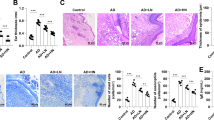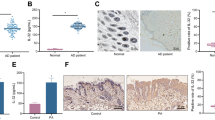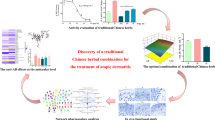Abstract
Background
Glabridin (GB), a bio-available phytoestrogen, displays various biological properties such as anti-inflammatory, antibacterial, and antiviral.
Objective
To explore the role of GB in the process of atopic dermatitis (AD).
Methods
CCK8 was used to detect the therapeutic effect of Glabridin in HaCat and NHEK cell inflammatory models. And evaluated the effect on cell proliferation and cell viability. The expression of TLR4, MyD88, P65 and P50 in HaCat and NHEK cell tissues was detected by qRT-PCR and PCR. At the same time, an AD animal model was constructed, and the cell experiment results were verified by hematoxylin–eosin (HE) and Immunohistochemistry staining (IHC).
Results
Enzyme-linked immunosorbent assay (ELISA) demonstrated that IL-1β, IL-6, and TNF-α upregulated by lipopolysaccharide (LPS) was decreased by treatment with GB. AD progression was further confirmed to be regulated by GB by inhibiting the TLR4/MyD88/NF-κB signaling pathway through real-time PCR and Western blot analyses. An AD-like mouse model demonstrated that GB considerably alleviated epidermal injury, relieve edema, and reduced inflammatory cell infiltration by H&E staining. Concurrently, IHC staining exhibited GB to reduce AD progression by impeding TLR4 expression.
Conclusion
GB was observed to decrease the AD progression by suppressing the TLR4/MyD88/NF-κB signaling pathway, which may likely serve as a novel therapeutic drug for AD management.





Similar content being viewed by others
References
Amber KTBR, Mrowietz U, Hertl M (2015) TNF-α: a treatment target or cause of sarcoidosis? J Eur Acad Dermatol Venereol 29:2104–2111
Blome CRM, Eissing L, Augustin M (2016) Quality of life in patients with atopic dermatitis: disease burden Measurement, and Treatment Benefit. Am J Clin Dermatol 17:163–169
LE Caso F, Del Puente A, Caso P, Peluso R, Foglia F, Benigno C, Girolimetto N, Bottiglieri P, Scarpa R, Costa L (2016) Progress in understanding and utilizing TNF-α inhibition for the treatment of psoriatic arthritis. Expert Rev Clin Immunol 12:315–331
Chiricozzi GYE, Suárez-Fariñas M, Nograles KE, Tian S, Cardinale I, Chimenti S, Krueger JG (2011) Integrative responses to IL-17 and TNF-α in human keratinocytes account for key inflammatory pathogenic circuits in psoriasis. J Invest Dermatol 131:677–687
Choi JKJY, Lee S, Lee SR, Choi YA, Jin M, Choi JH, Park JH, Park PH, Choi H, Kwon TK, Khang D, Kim SH (2017) Chrysin attenuates atopic dermatitis by suppressing inflammation of keratinocytes. Food Chem Toxicol 110:142–150
Danso MO, Mulder A, van Esch J, Scott H, van Smeden J, El Ghalbzouri A, Bouwstra JA (2014) TNF-α and Th2 cytokines induce atopic dermatitis-like features on epidermal differentiation proteins and stratum corneum lipids in human skin equivalents. J Invest Dermatol 134:1941–1950
El-Ashmawy NEKN, El-Bahrawy HA, El-Adawy SA (2018) Downregulation of iNOS and elevation of cAMP mediate the anti-inflammatory effect of glabridin in rats with ulcerative colitis. Inflammopharmacology 26:551–559
Fan HJZX, Tan ZB, Liu B, Xu HL, Wu YT, Xie LP, Bi YM, Lai YG, Liang HF, Zhou YC (2019) Effects and mechanism of action of Huang-Lian-Jie-Du-Tang in atopic dermatitis-like skin dysfunction in vivo and in vitro. J Ethnopharmacol 240:111937
Geoghegan JAIA, Foster TJ (2018) Staphylococcus aureus and atopic dermatitis: a complex and evolving relationship. Trends Microbiol 26:484–497
Guo J, Li J, Long J (2016) Knockdown of FSTL1 inhibits oxLDL-induced inflammation responses through the TLR4/MyD88/NF-κB and MAPK pathway. Biochem Biophys Res Commun 478:1528–1533
Kang MRPK, Oh SJ, Yun J, Lee CW, Lee MY, Han SB, Kang JS (2015) Cardiovascular protective effect of glabridin: Implications in LDL oxidation and inflammation. Int Immunopharmacol 29:914–918
Kim JKB, Ahn K, Leung DYM (2019) Interactions between atopic dermatitis and Staphylococcus aureus infection: clinical implications allergy asthma. Immunol Res 11:593–603
Kim WHAH, Kim JY, Gwon MG, Gu H, Lee SJ, Park JY, Park KD, Han SM, Kim MK, Park KK (2017) Apamin inhibits TNF-α- and IFN-γ-induced inflammatory cytokines and chemokines via suppressions of NF-κB signaling pathway and STAT in human keratinocytes. Pharmacol Rep 69:1030–1035
Lee HNSS, Choo GS, Kim HJ, Park YS, Kim BS, Kim SK, Cho SD, Nam JS, Choi CS, Che JH, Park BK, Jung JY (2018) Anti-inflammatory effect of quercetin and galangin in LPS-stimulated RAW264.7 macrophages and DNCB-induced atopic dermatitis animal models. Int J Mol Med 41:888–898
Li JGX, Liu RX (2019) Role of chinese herbal medicines in regulation of energy metabolism in treating cardiovascular diseases. Chin J Integr Med 25:307–315
Liu YYH, Zhao M, Lu Q (2014) TLR2 and TLR4 in autoimmune diseases: a comprehensive review. Clin Rev Allergy Immunol 47:136–147
Livak KJ (2001) Analysis of relative gene expression data using real-time quantitative PCR and the 2(–Delta Delta C(T))method. Methods (San Diego, Calif) 25:402–408
Mayba JNGM (2017) Review of atopic dermatitis and topical therapies. J Cutan Med Surg 21:227–236
Nakai KHY, Nishiyama F, Naruse F, Haba R, Kushida Y, Katsuki N, Moriue T, Yoneda K, Kubota Y (2017) IL-17A induces heterogeneous macrophages, and it does not alter the effects of lipopolysaccharides on macrophage activation in the skin of mice. Sci Rep 7:12473
Rahimifard MMF, Moeini-Nodeh S, Niaz K, Abdollahi M, Braidy N, Nabavi SM, Nabavi SF (2017) Targeting the TLR4 signaling pathway by polyphenols: a novel therapeutic strategy for neuroinflammation. Ageing Res Rev 36:11–19
Renert-Yuval YG-YE (2019) What’s New in Atopic Dermatitis. Dermatol Clin 37:205–213
Silverberg JIND, Yosipovitch G (2016) Addressing treatment challenges in atopic dermatitis with novel topical therapies. J Dermatolog Treat 27:568–576
Simmler CPG, Chen SN (2013) Phytochemistry and biological properties of glabridin. Fitoterapia 90:160–184
Smith MPLK, Thibodeaux Q, Weerasinghe T, Wu JJ, Yosipovitch G, Bhutani T, Liao W (2019) Emerging methods to objectively assess pruritus in atopic dermatitis. Dermatol Ther (Heidelb) 9:407–420
Srivastava NSA, Kumar M, Pant A, Das B, Majumdar T, Mazumder S (2017) Aeromonas hydrophila utilizes TLR4 topology for synchronous activation of MyD88 and TRIF to orchestrate anti-inflammatory responses in zebrafish. Cell Death Discov 3:17067
Sung YY (2018) Crocin Ameliorates Atopic Dermatitis Symptoms by down Regulation of Th2 Response via Blocking of NF-κB/STAT6 Signaling Pathways in Mice. Nutrients 10:1625
Tao YWY, Wang X, Wang C, Bao K, Ji L, Jiang G, Hong M (2017) calycosin suppresses epithelial derived initiative key factors and maintains epithelial barrier in allergic inflammation via TLR4 mediated NF-κB pathway. Cell Physiol Biochem 44:1106–1119
Wan JSY, Fan Y, Fan C, Chen S, Sun J, Zhu L, Qin L, Yu M, Lin Z (2016) NF-κB inhibition attenuates LPS-induced TLR4 activation in monocyte cells. Mol Med Rep 14:4505–4510
Wang GSG, Wang Y, Yu P, Wang X, Zhou B, Zhu H (2019) Glabridin attenuates endothelial dysfunction and permeability, possibly via the MLCK/p-MLC signaling pathway. Exp Ther Med 17:107–114
Wang PHX, Mo B, Huang G, Wang C (2017) LPS enhances TLR4 expression and IFN-γ production via the TLR4/IRAK/NF-κB signaling pathway in rat pulmonary arterial smooth muscle cells. Mol Med Rep 16:3111–3116
Wcisło-Dziadecka DZ-NM, Brzezińska-Wcisło L, Mazurek U (2016) TNF-α in a molecularly targeted therapy of psoriasis and psoriatic arthritis. Postgrad Med J 92:172–178
Yan ZLZ, Lin J (2017) Anticancer properties of traditional chinese medicine. Comb Chem High Throughput Screen 20:423–429
Yang WTZX, Chen S, Shan CS, Xu QQ, Zhu JZ, Bao XY, Lin Y, Zheng GQ, Wang Y (2017) Chinese herbal medicine for Alzheimer’s disease: clinical evidence and possible mechanism of neurogenesis. Biochem Pharmacol 141:143–155
Yang YLD, Xi Y, Li J, Liu B, Li J (2018) Upregulation of miRNA-140–5p inhibits inflammatory cytokines in acute lung injury through the MyD88/NF-κB signaling pathway by targeting TLR4. Exp Ther Med 16:3913–3920
Funding
The study was supported by the Scientific Research Fund of Inner Mongolia University for Nationalities (No. NMDYB1713).
Author information
Authors and Affiliations
Contributions
JC conceived and designed the experiments. JC and LW performed the experiments and MZ, ZL analyzed the data. JC wrote the paper. All authors read and approved the final manuscript.
Corresponding author
Ethics declarations
Conflict of interest
Jing Chang, Lin Wang, Minna Zhang and Zengjiao Lai declare that there are no conflicts of interest.
Additional information
Publisher's Note
Springer Nature remains neutral with regard to jurisdictional claims in published maps and institutional affiliations.
Rights and permissions
About this article
Cite this article
Chang, J., Wang, L., Zhang, M. et al. Glabridin attenuates atopic dermatitis progression through downregulating the TLR4/MyD88/NF-κB signaling pathway. Genes Genom 43, 847–855 (2021). https://doi.org/10.1007/s13258-021-01081-4
Received:
Accepted:
Published:
Issue Date:
DOI: https://doi.org/10.1007/s13258-021-01081-4




